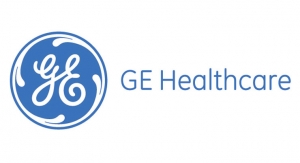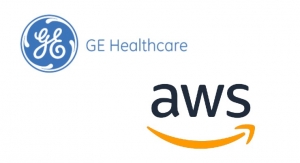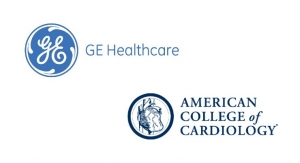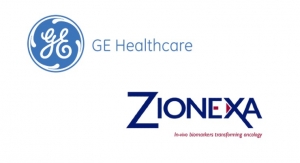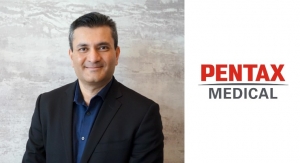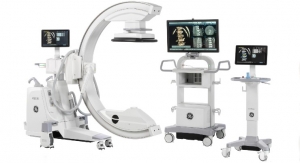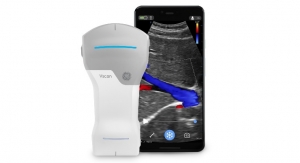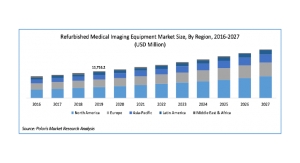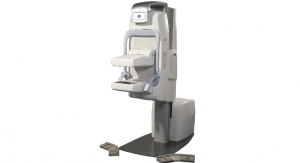07.30.19
AT A GLANCE
Rank: #3 (Last year: #3)
$19.78 Billion ($122B total)
Prior Fiscal: $19.02 Billion
Percentage Change: +4%
No. of Employees: 53,800 (283,000 total)
Global Headquarters: Chicago, Ill.
KEY EXECUTIVES
H. Lawrence Culp, Jr. Chairman and CEO, GE
Jamie S. Miller Sr. VP and CFO, GE
Kieran P. Murphy, Sr. VP, GE; President and CEO, GE Healthcare
Monish Patolawala, CFO, GE Healthcare
Amit Phadnis, Chief Digital Officer, GE Healthcare
Jan Makela, President and CEO, Global Services, GE Healthcare
Thomas Westrick, VP and Chief Quality Officer, GE Healthcare
Greg Gibbons, Chief Communications Officer, GE Healthcare
Terri Bresenham, Chief Innovation Officer, GE Healthcare
Ehren Powell, Chief Information Officer, GE Healthcare
Katya Kruglova, VP, Human Resources, GE Healthcare
Michael McAlevey, VP, General Counsel and Business Development, GE Healthcare
James W. Borzi, VP and Chief Supply Chain Officer, GE Healthcare
Anders Wold, President and CEO, GE Healthcare Clinical Care Solutions
Tom McGuinness, President and CEO, GE Healthcare Imaging
Emmanuel Ligner, President and CEO, GE Healthcare Life Sciences
Laurent Dubois, CEO, GE Healthcare Partners
Lee Cooper, President and CEO, GE Healthcare U.S. and Canada
Farid Fezoua, President and CEO, GE Healthcare Africa
Luiz Verzegnassi, President and CEO, GE Healthcare Latin America
Rachel Duan, President and CEO, GE Healthcare China
Soichiro Tada, President and CEO, GE Healthcare Japan
Nalinikanth (Nal) Gollagunta, President and CEO, GE Healthcare India and South Asia
Elie Chaillot, President and CEO, GE Healthcare Eastern Growth Markets
Catherine Estrampes, President and CEO, GE Healthcare Europe
Some had thought it possible that by the time this report on the GE Healthcare unit was being read, the firm would have been spun out as its own, standalone company. As it turns out, that timeline may have been anticipated a little prematurely. Due to several factors, GE Healthcare—to date—still remains a part of its conglomerate parent company, although no longer in its entirety as it was constructed at the start of 2018.
In late June 2018, it was announced by then-GE CEO John Flannery that GE Healthcare would be launched from the mothership to fend for itself as an independent entity. The unit’s split made sense from the standpoint—it was financially strong, provided an array of products, and would potentially thrive as a business with a single focus, catering exclusively to the technology needs of medicine. At the same time, GE would generate cash from the disposition of 20 percent of its interest in the firm to help reduce debt, while providing the remaining 80 percent to the parent company’s shareholders.
In a company statement, Kieran Murphy, president and CEO of GE Healthcare, who would have remained in the position to lead the new spun-out firm, said, “GE Healthcare’s vision is to drive more individualized, precise, and effective patient outcomes. As an independent global healthcare business, we will have greater flexibility to pursue future growth opportunities, react quickly to changes in the industry, and invest in innovation. We will build on strong customer demand for integrated precision health solutions and great technology with digital and analytics capabilities as we enter our next chapter.”
Or, at least, that was the plan. Unfortunately, as is said of best laid plans…
On Oct. 1, 2018, GE announced it had instead decided to spin out Flannery and replaced him with H. Lawrence Culp Jr., former CEO and president of Danaher. Culp had held his former role from 2001 to 2014. During his tenure, he led a number of strategic acquisitions and divestitures—perhaps the experience GE’s board valued given the firm’s intent to slim itself down. Further, according to the statement issued by GE at the time of the personnel change, while at Danaher, Culp saw the company’s market capitalization and revenues grow five-fold. Given the struggles the firm had been experiencing, GE certainly needed someone at the helm who had a proven history of positive financial experience.
The CEO swap generated immediate speculation on whether or not the GE Healthcare standalone launch would still take place. Jim Corridore, a research equity analyst at CFRA, told CNBC that Culp may not have the same plan for the healthcare segment. Meanwhile, corporate spokeswoman for GE, Jennifer Fox, assured, “Today’s news does not change what’s happening at GE Healthcare and it plans to continue working toward separation from GE.”
Not so fast, Fox.
By mid-November, plans were in a state of flux once again, Culp revealed in a discussion with CNBC’s David Faber. The CEO told the financial journalist and market news analyst that the Healthcare unit was a “tremendous” franchise and the parent company could “preserve our tax-free spin status while selling up to 49.9 percent” of the segment, significantly more than earlier statements, which put the percentage around 20. During the same interview, Culp revealed his former employer, Danaher, would “love” to own GE Healthcare’s Life Sciences business.
ANALYST INSIGHTS: The good news for GE Healthcare is that it continues to consistently move forward as a profitable business unit within GE. The bad news for GE Healthcare is that it continues to be a part of GE. GE continues to debate spinning off GE Healthcare as a separate business—via IPO. If this happens, it will be a positive for GE Healthcare as it will unleash the opportunity for strategic investments for its future growth. Otherwise, GE Healthcare will be challenged to keep up with its competitors for the long-term.
Still further fueling the rabid speculation over what the firm was up to, in the latter half of December, it was revealed GE had filed a “confidential IPO” for its healthcare unit. While the public filing was expected for the following (2019) spring, Bloomberg Intelligence analyst Karen Ubelhart estimated the enterprise value of the spinoff at $65 billion to $70 billion.
Finally, in late February 2019, as if in an effort to put to rest all the gossip and ballyhoo regarding the future of the Healthcare business unit, GE announced it was selling its biopharmaceutical business to Danaher. While the deal was likely not a surprise to anyone who had been keeping tabs on the comments made by Culp in the year prior, the transaction immediately called into question the further divestiture of any additional aspects of the medical technology segment. Culp, however, addressed any uncertainty regarding the public offering by stating the IPO was now “unlikely.”
The $21.4 billion deal with Danaher represented the sale of 15 percent of GE Healthcare’s business. The unit manufactures equipment and special resins that help pharma companies discover and mass produce biopharmaceuticals intended to fight autoimmune diseases. It also aids vaccine developers and researchers explore immunotherapy, according to GE.
Not included in the transaction was the Pharmaceutical Diagnostics unit, which develops contrast media for radiologists. Retaining that segment of the Life Sciences business makes sense since the media is used in combination with GE’s computed tomography, positron emission tomography, and magnetic resonance scanners.
While the spinout of GE Healthcare from the parent firm would have certainly been the biggest M&A move for the business in 2018, it certainly wasn’t the only one making headlines during the year. In April, the healthcare business sold its IT unit to Veritas Capital for $1.05 billion. The assets comprising the IT segment consisted of Enterprise Financial Management (Revenue-Cycle, Centricity Business), Ambulatory Care Management (Centricity Practice Solution), and Workforce Management (formerly API Healthcare).
In the news release announcing the sale, which closed two months later in June, Murphy said, “We’re confident this business will flourish under Veritas Capital, while GE Healthcare will continue to significantly invest in core digital solutions, such as smart diagnostics, connected devices, AI, and enterprise imaging, that will drive precision health for our customers. We will continue to lead in data analytics, command centers, advanced visualization, and image management tools to create better customer and patient outcomes.”
Earning two spots on GE Healthcare’s divestiture dance card, cancer diagnostics firm Inspirata waltzed away with both Omnyx in late January and Caradigm in mid-June; neither sale’s financial details were disclosed. Omnyx provides a digital platform to enable pathologists worldwide to work and collaborate to improve cancer diagnostics. Meanwhile, Caradigm offers a variety of population health solutions, including services based on data control, analytics, and care coordination and patient engagement.
Perhaps in another move to rid itself of assets deemed to be outside its dedicated focus on specific therapeutic segments, during the last quarter of 2018, GE Healthcare sold off all shares of NeoGenomics, a genetics-testing firm. It first sold shares in November valued at almost $70 million and followed that up with a final sale of all remaining shares in December—a move that returned $130 million to the company’s coffers.
That financial windfall was in addition to the $19.78 billion in revenues GE Healthcare saw in 2018—up 4 percent over the prior year—which represented a profit of $3.7 billion for the parent firm. The clear majority of that revenue was generated by the organization’s Healthcare Systems sub-segment, which contributed $14.9 billion in 2018, compared to $14.5 billion a year earlier. The other sub-segment that comprises GE Healthcare is the Life Sciences portion, which put $4.9 billion toward the revenue total (up from $4.6 billion in 2017). Given the divestiture of a significant piece of the Life Sciences unit to Danaher, this number will most certainly decrease in 2019.
When looking at GE Healthcare’s worldwide business, the figures reveal while the U.S. is the largest revenue generator compared to other regions, when compared to the total for the rest of the world, it represents the minority portion. Non-U.S. revenues accounted for 57 percent of the company’s overall figure, which translates to $11.2 billion (56 percent in 2017; $10.6 billion). To that number, Asia contributes the greatest portion at $5.2 billion, followed closely by Europe at $4.1 billion (compared to $4.9 and $3.9 billion respectively in 2017). The Americas ($1.0 billion) and Middle East/Africa ($0.9 billion) round out the 57 percent, each flat versus 2017. In contrast, the U.S. has a revenue figure of $8.6 billion, which was a slight increase over year prior ($8.4 billion).
Looking ahead, GE Healthcare is positioning itself rather well to serve the emerging trends in the medical treatment space—that is, the implementation of analytics and artificial intelligence (AI) in the clinical space. To that end, the firm developed a next-generation intelligence platform called Edison. The intent of this initiative is to enable smart product and new applications to be built on the platform. In doing so, Edison helps to accelerate the development and adoption of AI technology for the medical space. The solution will not only allow GE Healthcare to develop new “smart” technologies—clinical partners can use Edison to develop algorithms. Further, technology firms can team with GE Healthcare to introduce data processing advancements to medical devices and applications.
“There’s a lot of hidden meaning in the deep data, but it takes a significant sophistication to extract the value,” said Dr. Rachael Callcut, associate professor of surgery at UCSF, a surgeon at UCSF Health, director of data science for the Center for Digital Health Innovation, and a partner in the development of Critical Care Suite (one of several new healthcare solutions developed on Edison). “AI gives us an opportunity to see patterns that we don’t see and change the way we care for patients, which can ultimately improve outcomes.”
The aforementioned Critical Care Suite is designed to identify cases with the critical condition of pneumothorax at the point of care to enable prioritization of image review, according to an announcement made in late November 2018 regarding several new offerings all developed with the aid of Edison. AIRx, an AI-based, automated workflow tool for MRI brain scanning designed to increase consistency and productivity, was another. In addition, CT Smart Subscription provides continuous access to the latest CT software, extending the lifecycle of a device and making it more valuable over time. Rounding out the announced tools was an Automated Lesion Segmentation solution that helps eliminate the need for the user to measure lesions manually, by segmenting an identified breast, thyroid, or liver lesion and automatically providing a trace of the lesion and corresponding area.
“Edison provides clinicians with an integrated digital platform, combining diverse data sets from across modalities, vendors, healthcare networks and life sciences settings,” said GE Healthcare’s Murphy. “Applications built on Edison will include the latest data processing technologies to enable clinicians to make faster, more informed decisions to improve patient outcomes.”
Further illustrating its data/IT-centric focus, GE announced near the start of 2018 that it was teaming with Roche on a digital diagnostics platform for oncology and critical care treatment. The goal of the joint venture is to develop an industry-first digital platform to support clinical decisions by providing workflow solutions and apps. The system would leverage advanced analytics to enable the integration and analysis of in-vivo and in-vitro data, patient records, medical best practices, real time monitoring, and the latest research outcomes.
“This is the first time that two major players in healthcare have combined advanced analytics with in-vivo and in-vitro diagnostics to this degree. We believe this alliance will help accelerate the delivery of data-driven precision health for customers, patients, and the healthcare industry,” said Murphy.
Perhaps recognizing the leadership position GE had taken in the implementation of AI in the care space, NHS enlisted the company to build a centralized healthcare command center. The facility will be located at the Bradford Royal Infirmary, which is a teaching hospital in the U.K. A first-of-its-kind location in Europe, the center will utilize AI to transform how care is delivered and organized across the 800-bed hospital. Specifically, it will help to reduce unnecessary time spent in the hospital after a patient is medically ready to leave; increase the proportion of patients who arrive and are admitted, transferred, or discharged from A&E (i.e., the emergency department) within four hours; and help ensure patients are always treated in the wards best suited to manage their care. The center will be based on similar facilities in the U.S. and Canada, including The Johns Hopkins Hospital in Baltimore and Humber River Hospital in Toronto.
Catering to another rapidly growing trend in healthcare, the firm teamed with the Department of Veterans Affairs (VA) to accelerate the use of 3D printing in patient care. Specifically, the effort is seeking to reduce the time it takes for radiologists to create 3D-printed models and prosthetics from hours to minutes. The research agreement sees GE Healthcare providing software and work stations, while the VA will offer input on its use of the technology; the VA was previously using 3D software not intended for medical use.
“We are delighted to partner with the Veterans Administration to accelerate 3D printing in healthcare,” Terri Bresenham, chief innovation officer for GE Healthcare, said in a statement announcing the endeavor. “This partnership will result in significant innovation for the growing application of additive manufacturing in medicine while advancing GE Healthcare toward its mission to improve patient outcomes and enable precision healthcare.”
Rank: #3 (Last year: #3)
$19.78 Billion ($122B total)
Prior Fiscal: $19.02 Billion
Percentage Change: +4%
No. of Employees: 53,800 (283,000 total)
Global Headquarters: Chicago, Ill.
KEY EXECUTIVES
H. Lawrence Culp, Jr. Chairman and CEO, GE
Jamie S. Miller Sr. VP and CFO, GE
Kieran P. Murphy, Sr. VP, GE; President and CEO, GE Healthcare
Monish Patolawala, CFO, GE Healthcare
Amit Phadnis, Chief Digital Officer, GE Healthcare
Jan Makela, President and CEO, Global Services, GE Healthcare
Thomas Westrick, VP and Chief Quality Officer, GE Healthcare
Greg Gibbons, Chief Communications Officer, GE Healthcare
Terri Bresenham, Chief Innovation Officer, GE Healthcare
Ehren Powell, Chief Information Officer, GE Healthcare
Katya Kruglova, VP, Human Resources, GE Healthcare
Michael McAlevey, VP, General Counsel and Business Development, GE Healthcare
James W. Borzi, VP and Chief Supply Chain Officer, GE Healthcare
Anders Wold, President and CEO, GE Healthcare Clinical Care Solutions
Tom McGuinness, President and CEO, GE Healthcare Imaging
Emmanuel Ligner, President and CEO, GE Healthcare Life Sciences
Laurent Dubois, CEO, GE Healthcare Partners
Lee Cooper, President and CEO, GE Healthcare U.S. and Canada
Farid Fezoua, President and CEO, GE Healthcare Africa
Luiz Verzegnassi, President and CEO, GE Healthcare Latin America
Rachel Duan, President and CEO, GE Healthcare China
Soichiro Tada, President and CEO, GE Healthcare Japan
Nalinikanth (Nal) Gollagunta, President and CEO, GE Healthcare India and South Asia
Elie Chaillot, President and CEO, GE Healthcare Eastern Growth Markets
Catherine Estrampes, President and CEO, GE Healthcare Europe
Some had thought it possible that by the time this report on the GE Healthcare unit was being read, the firm would have been spun out as its own, standalone company. As it turns out, that timeline may have been anticipated a little prematurely. Due to several factors, GE Healthcare—to date—still remains a part of its conglomerate parent company, although no longer in its entirety as it was constructed at the start of 2018.
In late June 2018, it was announced by then-GE CEO John Flannery that GE Healthcare would be launched from the mothership to fend for itself as an independent entity. The unit’s split made sense from the standpoint—it was financially strong, provided an array of products, and would potentially thrive as a business with a single focus, catering exclusively to the technology needs of medicine. At the same time, GE would generate cash from the disposition of 20 percent of its interest in the firm to help reduce debt, while providing the remaining 80 percent to the parent company’s shareholders.
In a company statement, Kieran Murphy, president and CEO of GE Healthcare, who would have remained in the position to lead the new spun-out firm, said, “GE Healthcare’s vision is to drive more individualized, precise, and effective patient outcomes. As an independent global healthcare business, we will have greater flexibility to pursue future growth opportunities, react quickly to changes in the industry, and invest in innovation. We will build on strong customer demand for integrated precision health solutions and great technology with digital and analytics capabilities as we enter our next chapter.”
Or, at least, that was the plan. Unfortunately, as is said of best laid plans…
On Oct. 1, 2018, GE announced it had instead decided to spin out Flannery and replaced him with H. Lawrence Culp Jr., former CEO and president of Danaher. Culp had held his former role from 2001 to 2014. During his tenure, he led a number of strategic acquisitions and divestitures—perhaps the experience GE’s board valued given the firm’s intent to slim itself down. Further, according to the statement issued by GE at the time of the personnel change, while at Danaher, Culp saw the company’s market capitalization and revenues grow five-fold. Given the struggles the firm had been experiencing, GE certainly needed someone at the helm who had a proven history of positive financial experience.
The CEO swap generated immediate speculation on whether or not the GE Healthcare standalone launch would still take place. Jim Corridore, a research equity analyst at CFRA, told CNBC that Culp may not have the same plan for the healthcare segment. Meanwhile, corporate spokeswoman for GE, Jennifer Fox, assured, “Today’s news does not change what’s happening at GE Healthcare and it plans to continue working toward separation from GE.”
Not so fast, Fox.
By mid-November, plans were in a state of flux once again, Culp revealed in a discussion with CNBC’s David Faber. The CEO told the financial journalist and market news analyst that the Healthcare unit was a “tremendous” franchise and the parent company could “preserve our tax-free spin status while selling up to 49.9 percent” of the segment, significantly more than earlier statements, which put the percentage around 20. During the same interview, Culp revealed his former employer, Danaher, would “love” to own GE Healthcare’s Life Sciences business.
ANALYST INSIGHTS: The good news for GE Healthcare is that it continues to consistently move forward as a profitable business unit within GE. The bad news for GE Healthcare is that it continues to be a part of GE. GE continues to debate spinning off GE Healthcare as a separate business—via IPO. If this happens, it will be a positive for GE Healthcare as it will unleash the opportunity for strategic investments for its future growth. Otherwise, GE Healthcare will be challenged to keep up with its competitors for the long-term.
—Dave Sheppard, Co-Founder and Managing Director, MedWorld Advisors
Still further fueling the rabid speculation over what the firm was up to, in the latter half of December, it was revealed GE had filed a “confidential IPO” for its healthcare unit. While the public filing was expected for the following (2019) spring, Bloomberg Intelligence analyst Karen Ubelhart estimated the enterprise value of the spinoff at $65 billion to $70 billion.
Finally, in late February 2019, as if in an effort to put to rest all the gossip and ballyhoo regarding the future of the Healthcare business unit, GE announced it was selling its biopharmaceutical business to Danaher. While the deal was likely not a surprise to anyone who had been keeping tabs on the comments made by Culp in the year prior, the transaction immediately called into question the further divestiture of any additional aspects of the medical technology segment. Culp, however, addressed any uncertainty regarding the public offering by stating the IPO was now “unlikely.”
The $21.4 billion deal with Danaher represented the sale of 15 percent of GE Healthcare’s business. The unit manufactures equipment and special resins that help pharma companies discover and mass produce biopharmaceuticals intended to fight autoimmune diseases. It also aids vaccine developers and researchers explore immunotherapy, according to GE.
Not included in the transaction was the Pharmaceutical Diagnostics unit, which develops contrast media for radiologists. Retaining that segment of the Life Sciences business makes sense since the media is used in combination with GE’s computed tomography, positron emission tomography, and magnetic resonance scanners.
While the spinout of GE Healthcare from the parent firm would have certainly been the biggest M&A move for the business in 2018, it certainly wasn’t the only one making headlines during the year. In April, the healthcare business sold its IT unit to Veritas Capital for $1.05 billion. The assets comprising the IT segment consisted of Enterprise Financial Management (Revenue-Cycle, Centricity Business), Ambulatory Care Management (Centricity Practice Solution), and Workforce Management (formerly API Healthcare).
In the news release announcing the sale, which closed two months later in June, Murphy said, “We’re confident this business will flourish under Veritas Capital, while GE Healthcare will continue to significantly invest in core digital solutions, such as smart diagnostics, connected devices, AI, and enterprise imaging, that will drive precision health for our customers. We will continue to lead in data analytics, command centers, advanced visualization, and image management tools to create better customer and patient outcomes.”
Earning two spots on GE Healthcare’s divestiture dance card, cancer diagnostics firm Inspirata waltzed away with both Omnyx in late January and Caradigm in mid-June; neither sale’s financial details were disclosed. Omnyx provides a digital platform to enable pathologists worldwide to work and collaborate to improve cancer diagnostics. Meanwhile, Caradigm offers a variety of population health solutions, including services based on data control, analytics, and care coordination and patient engagement.
Perhaps in another move to rid itself of assets deemed to be outside its dedicated focus on specific therapeutic segments, during the last quarter of 2018, GE Healthcare sold off all shares of NeoGenomics, a genetics-testing firm. It first sold shares in November valued at almost $70 million and followed that up with a final sale of all remaining shares in December—a move that returned $130 million to the company’s coffers.
That financial windfall was in addition to the $19.78 billion in revenues GE Healthcare saw in 2018—up 4 percent over the prior year—which represented a profit of $3.7 billion for the parent firm. The clear majority of that revenue was generated by the organization’s Healthcare Systems sub-segment, which contributed $14.9 billion in 2018, compared to $14.5 billion a year earlier. The other sub-segment that comprises GE Healthcare is the Life Sciences portion, which put $4.9 billion toward the revenue total (up from $4.6 billion in 2017). Given the divestiture of a significant piece of the Life Sciences unit to Danaher, this number will most certainly decrease in 2019.
When looking at GE Healthcare’s worldwide business, the figures reveal while the U.S. is the largest revenue generator compared to other regions, when compared to the total for the rest of the world, it represents the minority portion. Non-U.S. revenues accounted for 57 percent of the company’s overall figure, which translates to $11.2 billion (56 percent in 2017; $10.6 billion). To that number, Asia contributes the greatest portion at $5.2 billion, followed closely by Europe at $4.1 billion (compared to $4.9 and $3.9 billion respectively in 2017). The Americas ($1.0 billion) and Middle East/Africa ($0.9 billion) round out the 57 percent, each flat versus 2017. In contrast, the U.S. has a revenue figure of $8.6 billion, which was a slight increase over year prior ($8.4 billion).
Looking ahead, GE Healthcare is positioning itself rather well to serve the emerging trends in the medical treatment space—that is, the implementation of analytics and artificial intelligence (AI) in the clinical space. To that end, the firm developed a next-generation intelligence platform called Edison. The intent of this initiative is to enable smart product and new applications to be built on the platform. In doing so, Edison helps to accelerate the development and adoption of AI technology for the medical space. The solution will not only allow GE Healthcare to develop new “smart” technologies—clinical partners can use Edison to develop algorithms. Further, technology firms can team with GE Healthcare to introduce data processing advancements to medical devices and applications.
“There’s a lot of hidden meaning in the deep data, but it takes a significant sophistication to extract the value,” said Dr. Rachael Callcut, associate professor of surgery at UCSF, a surgeon at UCSF Health, director of data science for the Center for Digital Health Innovation, and a partner in the development of Critical Care Suite (one of several new healthcare solutions developed on Edison). “AI gives us an opportunity to see patterns that we don’t see and change the way we care for patients, which can ultimately improve outcomes.”
The aforementioned Critical Care Suite is designed to identify cases with the critical condition of pneumothorax at the point of care to enable prioritization of image review, according to an announcement made in late November 2018 regarding several new offerings all developed with the aid of Edison. AIRx, an AI-based, automated workflow tool for MRI brain scanning designed to increase consistency and productivity, was another. In addition, CT Smart Subscription provides continuous access to the latest CT software, extending the lifecycle of a device and making it more valuable over time. Rounding out the announced tools was an Automated Lesion Segmentation solution that helps eliminate the need for the user to measure lesions manually, by segmenting an identified breast, thyroid, or liver lesion and automatically providing a trace of the lesion and corresponding area.
“Edison provides clinicians with an integrated digital platform, combining diverse data sets from across modalities, vendors, healthcare networks and life sciences settings,” said GE Healthcare’s Murphy. “Applications built on Edison will include the latest data processing technologies to enable clinicians to make faster, more informed decisions to improve patient outcomes.”
Further illustrating its data/IT-centric focus, GE announced near the start of 2018 that it was teaming with Roche on a digital diagnostics platform for oncology and critical care treatment. The goal of the joint venture is to develop an industry-first digital platform to support clinical decisions by providing workflow solutions and apps. The system would leverage advanced analytics to enable the integration and analysis of in-vivo and in-vitro data, patient records, medical best practices, real time monitoring, and the latest research outcomes.
“This is the first time that two major players in healthcare have combined advanced analytics with in-vivo and in-vitro diagnostics to this degree. We believe this alliance will help accelerate the delivery of data-driven precision health for customers, patients, and the healthcare industry,” said Murphy.
Perhaps recognizing the leadership position GE had taken in the implementation of AI in the care space, NHS enlisted the company to build a centralized healthcare command center. The facility will be located at the Bradford Royal Infirmary, which is a teaching hospital in the U.K. A first-of-its-kind location in Europe, the center will utilize AI to transform how care is delivered and organized across the 800-bed hospital. Specifically, it will help to reduce unnecessary time spent in the hospital after a patient is medically ready to leave; increase the proportion of patients who arrive and are admitted, transferred, or discharged from A&E (i.e., the emergency department) within four hours; and help ensure patients are always treated in the wards best suited to manage their care. The center will be based on similar facilities in the U.S. and Canada, including The Johns Hopkins Hospital in Baltimore and Humber River Hospital in Toronto.
Catering to another rapidly growing trend in healthcare, the firm teamed with the Department of Veterans Affairs (VA) to accelerate the use of 3D printing in patient care. Specifically, the effort is seeking to reduce the time it takes for radiologists to create 3D-printed models and prosthetics from hours to minutes. The research agreement sees GE Healthcare providing software and work stations, while the VA will offer input on its use of the technology; the VA was previously using 3D software not intended for medical use.
“We are delighted to partner with the Veterans Administration to accelerate 3D printing in healthcare,” Terri Bresenham, chief innovation officer for GE Healthcare, said in a statement announcing the endeavor. “This partnership will result in significant innovation for the growing application of additive manufacturing in medicine while advancing GE Healthcare toward its mission to improve patient outcomes and enable precision healthcare.”


